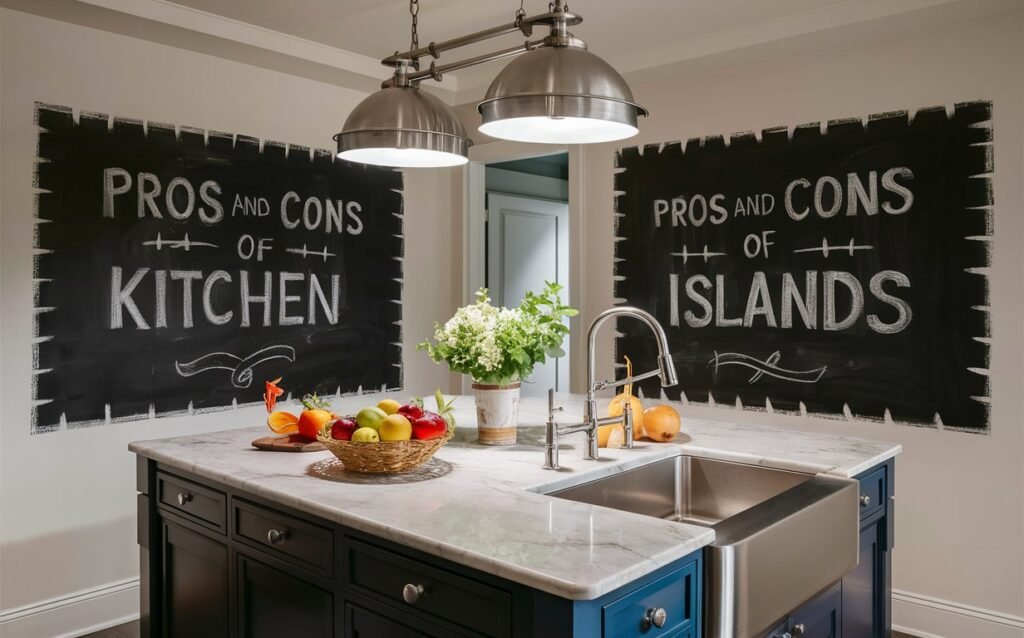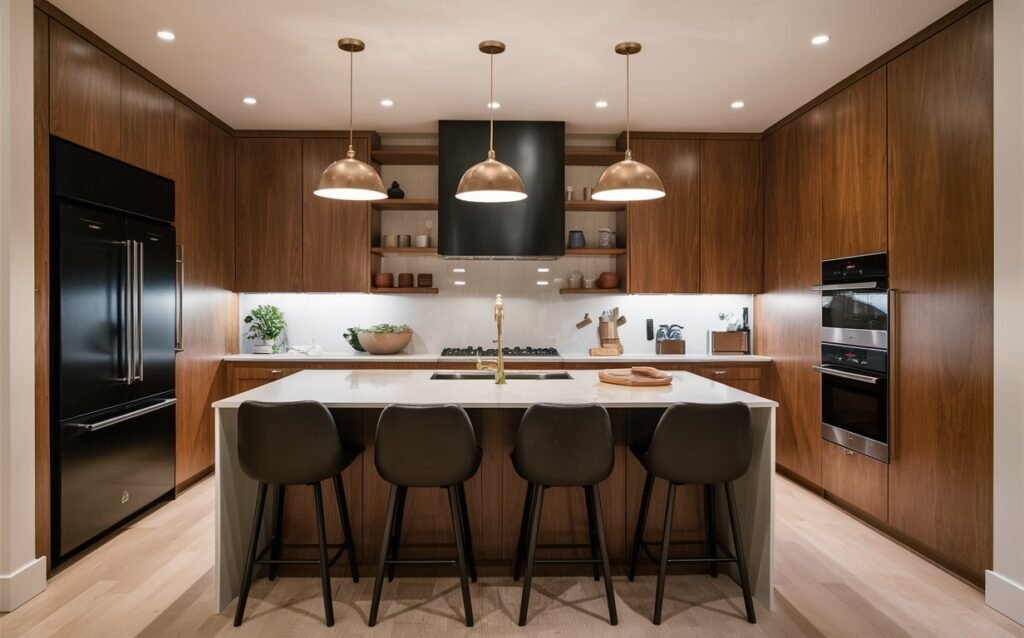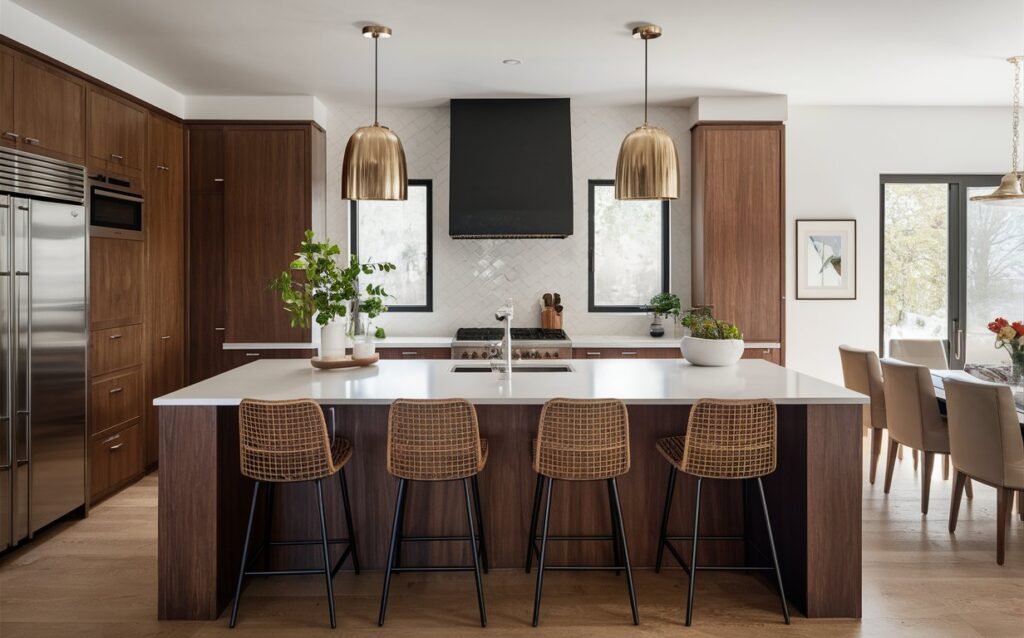Pros and Cons of Kitchen Islands
Thinking about adding a kitchen island? Explore the advantages and disadvantages, from extra counter space to potential clutter, and find out if a kitchen island is right for your home.
Introduction: What is a Kitchen Island?

A kitchen island is a free-standing cabinet that can either match your existing kitchen design or stand out as a unique piece. It typically includes a countertop, and sometimes cabinets or shelves underneath for storage. Many people add kitchen islands to their homes for extra counter space, additional storage, and a central place for family and friends to gather. However, like any home improvement, kitchen islands come with both advantages and disadvantages.
In this blog, we’ll discuss the pros and cons of kitchen islands to help you decide if this feature is right for your home.
The Benefits of Having a Kitchen Island: Why You Might Want One
- Extra Counter Space
One of the most significant benefits of a kitchen island is the additional counter space it provides. Whether you need more room for meal preparation, baking, or setting up a buffet for parties, a kitchen island can give you that much-needed extra space. - Additional Storage
Many kitchen islands come with built-in cabinets, drawers, and shelves. This can be incredibly useful for storing pots, pans, utensils, and even small appliances that you don’t use every day. Extra storage helps keep your kitchen organized and clutter-free. - Multifunctional Use
A kitchen island can serve many purposes. It can be a cooking area with a built-in stove, a prep area with a sink, or even a dining area where you can place bar stools for casual meals. This multifunctionality makes the kitchen island a versatile addition to any kitchen. - Improved Workflow
With a kitchen island, you can create a more efficient kitchen layout. By placing the island between the sink, stove, and refrigerator (known as the kitchen work triangle), you can streamline your cooking process and reduce the distance you need to move between these key areas. - Social Hub
A kitchen island often becomes the social center of the home. It provides a place where family and friends can gather, chat, and even help with meal preparation. This can make your kitchen a more inviting and interactive space. - Increased Home Value
Adding a kitchen island can boost the value of your home. Many homebuyers see a kitchen island as a desirable feature, and it can make your home more appealing if you ever decide to sell.
The Drawbacks of Having a Kitchen Island: Considerations Before Installation
- Requires Space
A kitchen island can take up a lot of space. If your kitchen is small, adding an island might make it feel cramped and difficult to move around. It’s essential to ensure you have enough room to accommodate an island without disrupting the flow of your kitchen. - Potential for Clutter
While kitchen islands can provide extra storage, they can also become a dumping ground for mail, keys, and other items. Without proper organization, your island can quickly become cluttered and messy. - Additional Cost
Installing a kitchen island can be expensive. Depending on the materials, features, and size of the island, costs can add up quickly. It’s important to consider your budget and whether the benefits of an island justify the expense. - Possible Disruption of Workflow
In some cases, a kitchen island can disrupt the natural workflow of your kitchen. If not placed correctly, it can create obstacles and make it harder to move between the sink, stove, and refrigerator. - Maintenance and Cleaning
A kitchen island requires regular maintenance and cleaning, just like any other part of your kitchen. If your island has a sink or stove, you’ll need to clean these areas frequently to prevent buildup and maintain hygiene. - Design Challenges
Incorporating a kitchen island into your existing kitchen design can be challenging. It’s important to ensure the island complements your kitchen’s style and doesn’t look out of place. This might require professional help from a designer or contractor.
Different Types of Kitchen Islands: Exploring Your Options
- Portable Kitchen Islands
Portable or mobile kitchen islands are not fixed to the floor and can be moved around. They often come with wheels for easy mobility. These islands are great for smaller kitchens where space is limited, as they can be moved out of the way when not in use. - Built-In Kitchen Islands
Built-in kitchen islands are permanent fixtures in your kitchen. They are custom-designed to fit your space and can include features like sinks, stoves, and built-in appliances. These islands are ideal for larger kitchens and offer a more polished and integrated look. - Double-Tiered Kitchen Islands
Double-tiered or two-level kitchen islands have two separate countertop levels. The higher level can be used as a bar or dining area, while the lower level is used for food preparation. This design is perfect for entertaining guests while still being able to cook and prepare meals. - L-Shaped Kitchen Islands
L-shaped kitchen islands have a unique shape that provides more countertop and storage space. They can help define different areas in an open-plan kitchen and provide plenty of room for multiple people to work at the same time. - Island with Built-In Appliances
Some kitchen islands come with built-in appliances like a stove, oven, or dishwasher. This design can help free up counter space in the rest of your kitchen and create a more efficient cooking area.
Key Features to Consider When Designing a Kitchen Island: Making the Right Choices
- Size and Proportion
The size of your kitchen island should be proportional to the size of your kitchen. An island that is too large can overwhelm the space, while one that is too small may not provide enough functionality. - Storage Options
Consider what type of storage you need. Cabinets, drawers, and shelves can all be incorporated into your island to meet your storage needs. Think about what items you want to store and how you want to organize them. - Countertop Material
The material you choose for your island’s countertop can impact its durability, maintenance, and appearance. Popular options include granite, quartz, marble, and butcher block. Each material has its own pros and cons, so choose one that fits your lifestyle and design preferences. - Seating Arrangement
If you plan to use your island as a dining or seating area, consider the height and type of seating. Bar stools, chairs, and benches can all be used, depending on the height of your island and the look you want to achieve. - Lighting
Proper lighting is essential for a functional kitchen island. Pendant lights are a popular choice, as they provide focused light and add a decorative element. Ensure your island is well-lit for cooking, eating, and socializing. - Electrical Outlets
Adding electrical outlets to your kitchen island can increase its functionality. Outlets are useful for plugging in small appliances, charging devices, and providing additional power sources for cooking.
How Shree Interior Wudtech Can Help: Expert Solutions for Your Kitchen Island Needs

At Shree Interior Wudtech, we specialize in modular furniture and kitchen solutions that enhance your living space. Our team of experts can help you design and install the perfect kitchen island for your home. Whether you’re looking for extra counter space, additional storage, or a multifunctional centerpiece for your kitchen, we have the skills and experience to make your vision a reality.
Conclusion: Weighing the Pros and Cons
Kitchen islands offer many benefits, including extra counter space, additional storage, and a central gathering place for family and friends. However, they also come with potential drawbacks, such as space requirements, cost, and maintenance. By carefully considering the pros and cons and working with experienced professionals like Shree Interior Wudtech, you can determine if a kitchen island is the right choice for your home.
Investing in a kitchen island can transform your kitchen into a more functional and inviting space. Whether you opt for a portable, built-in, or double-tiered island, the key is to choose a design that fits your needs and complements your kitchen’s style. With the right planning and execution, a kitchen island can become the heart of your home, providing years of enjoyment and utility.
FAQs – Kitchen Islands
1. What is the ideal size for a kitchen island?
The ideal size for a kitchen island depends on the size of your kitchen. Generally, you should allow at least 36 to 48 inches of space around the island for easy movement. The island itself should be at least 4 feet long and 2 feet deep to provide adequate workspace and storage.
2. Can I add a kitchen island to a small kitchen?
Yes, you can add a kitchen island to a small kitchen, but it’s important to choose a compact design that doesn’t overcrowd the space. Portable or mobile kitchen islands are a good option for smaller kitchens as they can be moved out of the way when not in use.
3. What materials are best for a kitchen island countertop?
Popular materials for kitchen island countertops include granite, quartz, marble, and butcher block. Each material has its pros and cons: granite and quartz are durable and low-maintenance, marble offers a luxurious look but requires more care, and butcher block provides a warm, natural appearance but can be prone to scratches and stains.
4. How can I ensure my kitchen island complements my existing kitchen design?
To ensure your kitchen island complements your existing kitchen design, choose materials, colors, and finishes that match or harmonize with your current cabinetry and countertops. Consider consulting with a professional designer to achieve a cohesive look.
5. Are there any special considerations for kitchen islands with built-in appliances?
Yes, kitchen islands with built-in appliances like stoves, sinks, or dishwashers require careful planning for plumbing, electrical connections, and ventilation. It’s essential to work with a professional to ensure proper installation and compliance with building codes.
6. How can I maximize storage in my kitchen island?
To maximize storage in your kitchen island, consider incorporating a combination of cabinets, drawers, and open shelves. Utilize pull-out trays, lazy Susans, and custom organizers to make the most of the available space and keep items easily accessible.
7. What are the maintenance requirements for a kitchen island?
The maintenance requirements for a kitchen island depend on the materials used. Regular cleaning with appropriate products is essential. For example, granite and quartz countertops should be wiped down with a mild cleaner, while butcher block requires periodic oiling. If your island includes appliances, sinks, or stoves, these will require additional cleaning and maintenance.
8. Can a kitchen island increase my home’s resale value?



